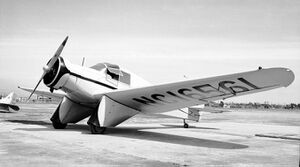Engineering:Aeronca L
| Aeronca L | |
|---|---|

| |
| An Aeronca LB | |
| Role | Cabin monoplane |
| National origin | United States of America |
| Manufacturer | Aeronca Aircraft |
| Introduction | 1935 |
| Primary user | Private pilot owners |
| Number built | 65 |
The Aeronca L was a 1930s United States cabin monoplane designed and built, in small numbers, by Aeronca Aircraft. It differed significantly from other Aeronca planes by the use of radial engines, streamlining, and a cantilever low wing.[1][2]
Design and construction
Quite unlike other Aeronca designs, the Model L was a "cantilever" (no external struts for bracing) low-wing monoplane, that featured side-by-side seating in a completely enclosed cabin.[1][2] The design reflected the greater attention being paid to aerodynamics in the period, including large wheel spats for the fixed undercarriage[1] and a Townend ring for the engine.[3] The aircraft was of mixed-construction with a welded steel fuselage and wings with spruce spars and ribs, all covered with fabric.
Initial attempts to use Aeronca's own engines proved inadequate, and the company turned to small radial engines from other suppliers, particularly neighboring Cincinnati engine manufacturer LeBlond.[1][2]
Operational history
The Model L was mainly flown by private pilot owners. The plane was not a big seller. Difficulty with engine sources, and a destructive flood, in 1937, at Aeronca's factory at Cincinnati's Lunken Airport, took the energy out of the program, and Aeronca went back to high-wing light aircraft.[1][2]
With the end of sales to Aeronca, LeBlond sold their engine-manufacturing operation to an Aeronca-rival planemaker, Kansas City-based Rearwin Aircraft, who resumed production of the engines under the brand name "Ken-Royce," largely for use in Rearwin planes.[1][2]
Variants
- LA
- Fitted with a 70 hp (52 kW) LeBlond 5DE engine, 9 built
- LB
- Fitted with an 85 hp (63 kW) LeBlond 5DF engine, 29 built
- LC
- Fitted with a 90 hp (67 kW) Warner Scarab Jr engine, 15 built
- LCS
- A single LC, [NC16289], was fitted with floats to become the LCS, carrying a load of 659 lb (299 kg) for 450 mi (391 nmi; 724 km) at 100 mph (87 kn; 161 km/h).
- LD
- Fitted with a 90 hp (67 kW) Lambert R-266 5-cyl. radial engine
Surviving aircraft
The EAA AirVenture Museum in Oshkosh, Wisconsin has a 1937 Aeronca LC in its collection.[3]
The Western Antique Aeroplane & Automobile Museum of Hood River, Oregon, has an airworthy Aeronica LC. Aeronca LB N16271 was in final stages of restoration as of January of 2015; Aeronca LC NC17442 (cn 2056) is also on display in the museum.[4]
Specifications (Model LC)
Data from American airplanes: Aeronca[5]
General characteristics
- Crew: 1
- Capacity: 1 passenger / 646 lb (293 kg) payload
- Length: 22 ft 6 in (6.86 m)
- Wingspan: 36 ft (11 m)
- Height: 7 ft (2.1 m)
- Wing area: 150 sq ft (14 m2)
- Airfoil: root: NACA 2218; tip: NACA 2209[6]
- Empty weight: 1,034 lb (469 kg)
- Max takeoff weight: 1,852 lb (840 kg)
- Powerplant: 1 × Warner Scarab Junior 5-cylinder air-cooled radial piston engine, 90 hp (67 kW)
- Propellers: 2-bladed fixed-pitch propeller
Performance
- Maximum speed: 123 mph (198 km/h, 107 kn)
- Cruise speed: 105 mph (169 km/h, 91 kn)
- Stall speed: 45 mph (72 km/h, 39 kn)
- Range: 535 mi (861 km, 465 nmi)
Notes
- ↑ 1.0 1.1 1.2 1.3 1.4 1.5 Harris, Richard, "Aeronca: Birth of the Personal Plane ," AAHS Journal, Summer 2007, vol.52, #2, American Aviation Historical Society
- ↑ 2.0 2.1 2.2 2.3 2.4 Harris, Richard, "Aeronca/Champion History: Beyond the Bathtub -- Chiefs, Champs & Citabrias," from articles first appearing in In Flight USA, 2003-2004, condensed on author's website, retrieved Jan. 31, 2016.
- ↑ 3.0 3.1 "Aeronca LC". Archived from the original on 16 March 2011. https://web.archive.org/web/20110316110830/http://museum.eaa.org/collection/aircraft/Aeronca%20LC.asp#TopOfPage. Retrieved 20 March 2011.
- ↑ "Aeronca LC". http://rpdoody.zenfolio.com/p379296291/h124B7617#h124b7617. Retrieved 9 October 2012.
- ↑ Eckland, K.O.. "American airplanes: Aeronca". http://aerofiles.com/_aeron.html. Retrieved 20 November 2020.
- ↑ Lednicer, David. "The Incomplete Guide to Airfoil Usage". https://m-selig.ae.illinois.edu/ads/aircraft.html. Retrieved 16 April 2019.
References
- Taylor, J. H. (ed) (1989) Jane's Encyclopedia of Aviation. Studio Editions: London. p. 31
- Holcomb's Aerodrome
 |

